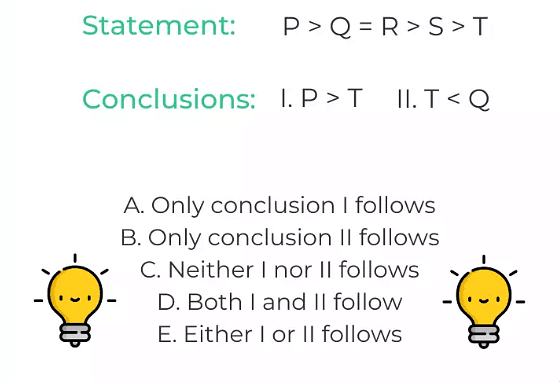Tips and Tricks: Statement and Conclusions | General Intelligence and Reasoning for SSC CGL PDF Download
Tips and Tricks for Statements and Conclusion
Here, are some quick and easy Tips and Tricks for Statements and Conclusion for you to follow and solve Objective Reasoning questions competently in competitive exams.
- Sometimes the statement can go against any fact or any prevailing concept of truth.
- The keywords like always, only, exactly, at least, and so on make the conclusion unclear and invalid.
- There cannot be any mutual contradiction if the statement is consists of two or more sentences.
- The conclusion is invalid if it is provided with a specified example.
- The words such as all, few, most, must, no, had to, will be, always, few, never, should be, may, may not will help in analyzing valid and invalid conclusion.

Tips and Tricks and Shortcuts for Statements and Conclusion Questions:
There are 2 types of questions asked in exam:
Type 1: Direct Conclusion
Q1:
Statement:
Some people say that bad thought come to their mind when they try to sleep.
Conclusion:
I. Only few people see bad thought while sleeping.
II. All good thought come in the morning.
(a) Only conclusion I follows
(b) Only conclusion II follows
(c) Either I or II follows
(d) Neither I nor II follows
Ans: (a)
It is clearly mentioned in the statement that some people say that bad thought come to their mind while sleeping and not all people. So, conclusion I follows the statement. It is not mentioned anywhere in the sentence that only bad thoughts come in morning. Therefore, conclusion II does not follow the statement.
Type 2: Indirect Conclusion
Q2:
Statement:
The recruitment committee has decided to shortlist those applicants who have minimum 60% throughout their career. Anirudh has secured 75% in 10th and 57% in 12th standard. She graduated in science field with 78%.
Conclusion:
I. Anirudh will be shortlisted
II. Anirudh will not be shortlisted
(a) Only conclusion I follows
(b) Only conclusion II follows
(c) Either I or II follows
(d) Neither I nor II follows
Ans: (b)
Anirudh scored 75% in 10th and 78% in graduation. But he scored only 57% in 12th standard. Therefore, he will not be shortlisted.
Case 1: When only conclusion I follows
Q1:
Statement:
If Sangeeta will work consistently and hard, she will definitely pass the exam.
Conclusion:
I. Consistency and hard work is required to pass every exam.
II. Some people can pass the exam without consistency and hard work.
(a) Only conclusion I follows
(b) Only conclusion II follows
(c) Either I or II follows
(d) Neither I nor II follows
Ans: (a)
It is very clear from the statement that to pass an exam one needs to work hard and consistently. It is not given in the statement that some people can pass even without working hard. Therefore, only conclusion I follows the statement.
Case 2: When only conclusion II follows
Q2:
Statement:
Always consult your financial and investment advisor before investing in securities.
Conclusion:
I. No one should invest in securities.
II. The investment advisor analyzes the market risk and advices where and when to invest.
(a) Only conclusion I follows
(b) Only conclusion II follows
(c) Either I or II follows
(d) Neither I nor II follows
Ans: (b)
In the statement above it is clearly mentioned that one should always consult the advisor before investing as he gives proper advice analyzing the market risk with the certainty. Nowhere in the sentence is it mentioned that no one should invest in market security. Therefore, only conclusion II follows.
Case 3: When neither conclusion 1 nor 2 follows
Q3:
Statement:
In India more emphasis is given to pure and basic science rather than on engineering or technological field.
Conclusions:
I. The production industry in India has always been neglected.
II. India is sufficiently developed in basic and pure science.
(a) Only conclusion I follows
(b) Only conclusion II follows
(c) Either I or II follows
(d) Neither I nor II follows
Ans: (d)
The statement above states that in India more emphasis is laid on pure and basic science but it is not mentioned that India is sufficiently developed in those field. Therefore, conclusion II does not follow the statement. Similarly, nothing about production industry is mentioned in the statement. Thus, conclusion I does not follow the statement.
 |
Download the notes
Tips and Tricks: Statement and Conclusions
|
Download as PDF |
Case 4: When either conclusion 1 or 2 follows
Q4:
Statement:
Government representative stated that “We will soon review the rule that needs to be changed according to public.”
Conclusion:
I. The government will change the rules
II. The government will not change the rules
(a) Only conclusion I follows
(b) Only conclusion II follows
(c) Either I or II follows
(d) Neither I nor II follows
Ans: (c)
The government representative not clearly stated whether the rules would change or not. He just stated that it will be reviewed. So, in this situation, either of both the conclusions can be determined.
Case 5: When both conclusion 1 and 2 follows
Q5:
Statement:
Those students who do not behave properly in the class brings a bad name to both the family and the school itself.
Conclusion:
I. The students who do not behave properly should be taught discipline both in school and at home.
II. Students who do not behave properly in class create a bad impact on other students.
(a) Only conclusion I follows
(b) Only conclusion II follows
(c) Either I or II follows
(d) Both I and II follow
The statement clearly states that students with bad behavior brings bad name to family and friends, so we can conclude that discipline should be taught to them and they also create bad impact on other students.
|
177 videos|129 docs|197 tests
|






















